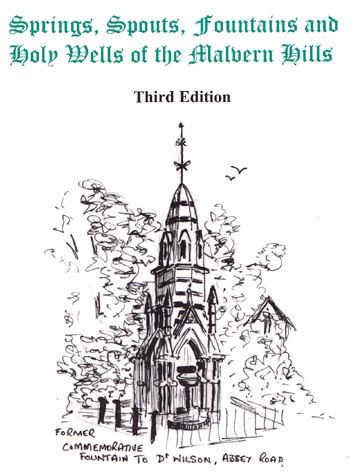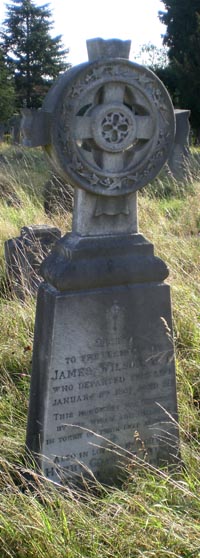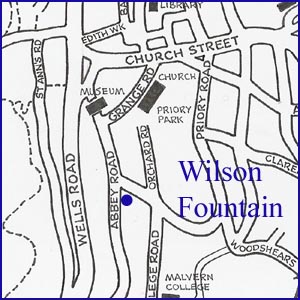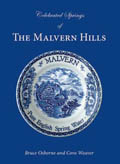
| 
|


Wilson Memorial Fountain
NGR 77520 45715
Site Number: C94
By Bruce Osborne and Cora Weaver (C) 2012
Area 1. Malvern Town Centre Springs and Wells
Malvern Hills, England
Description: A vast ornamental fountain with inscribed marble tablet.
This original elaborate drinking fountain was erected in memory of Dr James Wilson (1807-67), one of the country's leading hydrotherapy doctors who introduced hydrotherapy and wealth to Malvern in 1842. Following Dr Wilson's unexpected death at Ilkley Wells it was decided to erect a memorial fountain to him [1] and a Wilson Memorial Committee to mastermind the project was formed, consisting of Lord Lytton, Dr Gully and Dr Stummes.[2] The fountain was to be of granite, of very elegant design, be both an ornament and a public utility and would cost not less than 300 pounds.[3] People subscribed to the fund and by the following year the money was raised.
Malvern Goes to Sleep - Fifteen months later a correspondent to the local paper asked what had become of the Wilson Memorial Fountain and suggested it should be both a public fountain and a clock tower because Malvern had no public clock; also that Belle Vue Terrace would be a suitable location.[4] Exactly one year later a letter was read to the Board from Dr Gully asking when a memorial fountain was to be erected to Dr Wilson since UK pounds 300 had been raised for the project. The Local Board said it would be grateful to receive plans from Dr Gully.[5]
Not much happened until July 1870, when Dr Gully applied to erect the fountain on a plot of land owned by Miss Palmer of South Abbotsfield. The plot was near the public fountain erected by Major Ward-Jackson, and some of the Board members felt it would be better to space out the fountains. However, it was decided that since the site was near Wilson's former hydropathic establishment it seemed appropriate.[6] Two years passed and Gully retired and moved to London.
In 1874 Dr.Rayner was instructed to find a suitable site for the fountain where it would not be necessary to fell trees[7] so he went to see Miss Palmer about the site which Gully had earmarked. She was happy to donate the land on condition that no more than one of the 3 or 4 trees on the proposed site would be felled and that the seats on the site be judiciously moved so that they would still be in the shade.[8]
More than two years passed before Mr Archer, Chairman of the Board's Water Committee, stressed that he wanted to see the Wilson memorial completed,[9] 25 pounds was to be spent on a retaining wall round the Memorial site; a bench had been removed to accommodate the new fountain, three replacement seats needed to be installed for the use of the public[10] and 3 pounds was to be spent altering the position of the arch of Major Ward-Jackson's Spout which was located just below the proposed Wilson Memorial.[11] This was probably when the Major's crest and initials were removed from the stonework.
Ten years after Dr Wilson's death the Memorial Fountain was finally designed by local architects George and Henry Haddon. Shropshire Grinshall stone was used for the general structure; the plinth, base and steps were of Forest of Dean blue stone; the basins and pilasters of Portland grey stone, and the columns of Aberdeen and Peterhead granite.[12] It was constructed by builder William Porter of Malvern Wells and connected to a water supply from Major Ward-Jackson's spring at Melton Lodge. The new fountain was indeed impressive. The elaborate design says much about the Victorian values that were incorporated into its creation: its water refreshed the body and its beauty refreshed the spirit.
A marble plaque read:
'This fountain is erected by the friends and patients of the late Dr James Wilson MD in commemoration of his having introduced into England and for many years successfully practised in this town the treatment called "Hydrotherapy" thereby greatly promoting the development and prosperity of Malvern Anno Domini 1877'
By 8th September 1877 there were still no seats at the Wilson Memorial Fountain; by 1st February 1879 there was no drinking vessel, and it appears there never had been. By the following month the seats that formerly stood on the site had been repaired, but not reinstated, and it was only decided to reinstate them following complaints that there were very few seats in the town. It was a shameful memorial to the man who had done so much for Malvern's prosperity. God had presented Malvern with three good things - pure water, beautiful hills, and Dr Wilson - and the town had done nothing at all to enhance these gifts.
In April 1882 Melton Lodge was sold and the following month the Local Board's Gas and Water Committee asked Dr Wilson's widow, Clara, if she would present the Wilson Memorial Fountain to the town. She agreed, on condition that the Board kept it in good repair, protected it from injury and supplied the water, which they agreed to do. The approach was made because for some time the fountain had been practically useless through want of water. The Board decided to act then since Melton Lodge had just changed hands and the present water arrangement could be reviewed.[13] The Board's successor (Malvern Urban District Council) neither remembered nor maintained the bargain. In 1897 it was noted that the fountain was neglected: there was no water and no cups, and the ground around the edifice was overgrown with weeds. The Council decided that the owner should be found and asked if he or she minded the fountain being tidied up. Mrs Wilson had died in 1888, and her only son, Henry, in 1881, so another member of the family had to be located to grant permission for the Council to maintain their own property.[14]
With inattentiveness skillfully developed over many years the issue was dropped, only to be revived on a hot summer day two years later in a letter to the local paper.
"Sir - Coming into Malvern from the Wells the other morning, after a long and dusty walk, my eyes were gladdened by the sight of a drinking fountain in the Abbey Road, under the shade of a green tree. I went to the shady part of the fountain, thinking the water would be coolest on that side. I found the drinking cup, a sort of scallop shell-shaped piece of tin, lying in the hollow, not looking at all tempting, but worst of all, on pressing the spring but no water came. I then went to the other side, and, lo, there was no button at all, the thing was gone. I need hardly say I felt sadly disappointed, and perhaps the powers that be will see to it, and thus help.
A POOR THIRSTY TRAVELLER [15]
By 1904 young trees were growing out of the stonework and the fountain was too dirty for anyone to use.[16] In 1924, during a council discussion about putting a new fountain in Rose Bank Gardens, the question was raised whether the new fountain 'would be better for drinking purposes than the treatment meted out at the Wilson Fountain in Abbey Road? They had there a double one in a sad and sorry state of neglect'.[17]
During the Second World War the railings were removed from the fountain as part of the war effort to secure scrap metal. By October 1946 the Council had received complaints about the derelict and dangerous state of the Wilson Memorial and it was decided that unless sufficient reasons were submitted for its retention, the memorial would be demolished. Having ignored the relic for the whole of its useful life the idea of losing it spurred the townsfolk into action. So many letters of protest were sent from corporate bodies and individuals that three months later the Council decided to spend 60 pounds on restoration and reserve 10 pounds annually for routine maintenance. However it was the town's negligence which ultimately decided the fountain's future. It was found to be too dilapidated and dangerous to preserve and after a dismal and ignominious existence, the Surveyor reported to the Council Committee on 4 May 1948 that the Wilson Memorial Fountain had been demolished. The only piece to be rescued was the commemorative plaque which now rests in Malvern Museum at the Priory Gatehouse.
That is not the end of a long and sad story of vandalism and disrespect. Dr Wilson is buried in the local Malvern cemetery, where his gravestone can still be seen. Some years ago, for health and safety reasons, the Council decided to topple 'unsafe' gravestones. The cemetery was officially vandalised and littered with fallen stones. Fortunately, hasty representations by members of the public resulted in this Wilson memorial being reinstated.
The fountain is illustrated in several local history books;
1) "Portrait of Malvern" 1985 by Hurle and Winsor. p30.
2) "James M Gully" 1983 by Mann. p36.
Dr Wilson was born in December 1807 at Holywell in Flintshire and studied in London, Paris and Dublin. He would have been well aware of ancient St Winefride's Well at Holywell, one of the most celebrated places of pilgrimage and healing in the British Isles. It was established in the seventh century as a shrine and survived the vicissitudes of the Reformation resulting in an unbroken history of worship. At the time when Wilson was growing up, Holywell was a thriving religious centre with waters used in a variety of hydrotherapeutic ways to cure the sick. With an inevitable interest in the efficacy of St Winefride's waters, as a doctor, young Wilson would have referred to the authoritive works of the day on Mineral Waters. William Saunders was one such principal authority publishing his Treatise on Mineral Waters in several editions in the early part of the nineteenth century. The science of chemistry was beginning to be understood and Saunders noted specifically in his work the similarity between Malvern Waters and those of Holywell.[18]

In the early 1840s Wilson, then in his thirties, travelled through Europe where he came across Priessnitz, a local entrepreneur, successfully establishing and practising hydrotherapy in Graefenberg, now Jesenic, a spa in Silesia. He would also have heard of Kneipp, a Bavarian pastor who at the time was also refining hydrotherapeutic techniques. Recollecting the curative properties of St Winifreds waters, Wilson would have seen the potential for refining the practice of hydrotherapy in England as an alternative to the bizarre methods of traditional medicine. Joining forces with his old friend Dr Gully, Malvern was ideally suited to establish a practice, the water being similar to the proven St Winefride's Well and there being a history of local waters being used for hydrotherapy.
The real opportunity came however with changing legislation on asylums. The Lunatic Asylums Acts of 1828 and 1845 meant that no one could enter a madhouse or asylum without the certification of two doctors. This avoided incarceration without cause but put a stop to voluntary admissions. Prior to this, private asylums had treated various "nervous" complaints, a market which subsequently became the stock-in-trade of the hydropathic establishments. Individuals such as Tennyson and Darwin, following nervous breakdowns, were no longer prepared to pursue the private asylums as a place of rest if it meant certification. Instead the water cure establishments of Malvern offered rest, healthy routine, sensible diet and hydrotherapy, all under the professional eye of an experienced Doctor.
Wilson and Gully therefore chose Malvern for its waters at an opportune time. They refined and marketed hydrotherapy as part of a cure for those particularly suffering from nervous disorders.
Following an enterprising career in Malvern, on 8th January 1867 Dr James Wilson died at the Ilkley Wells Hydropathic Establishment, where he was visiting with a view to a rest and a change. His choice of Ilkley was no doubt influenced by the fact that Ilkley waters were perceived as similar to those of Malvern.[19]
Illustrations:
[1] Malvern Advertiser 2 February 1867.
[2] Malvern News 26 January 1867
[3] Malvern Advertiser 2 Feb 1867
[4] Malvern Advertiser 9 May 1868.
[5] Malvern Advertiser 29 May 1869.
[6] Malvern Advertiser 9 July 1870.
[7] Malvern Advertiser 18 July 1874.
[8] Malvern Advertiser 1 August 1874.
[9] Malvern Advertiser 18 November 1876.
[10] Malvern Advertiser 24 February 1877.
[11] Malvern Advertiser, 8 September 1877.
[12] The Architect, 26 June 1875.
[13] Malvern Advertiser, 12 May 1883.
[14] Malvern Advertiser 27 Mar/3 Apr 1897.
[15] Malvern Advertiser 10 June 1899.
[16] Malvern Gazette 30 Sept 1904.
[17] Malvern Gazette 6 June 1924
[18] Saunders W. second ed. 1805 p.109.
[19] Mackenzie P, Practical Observations on the Medicinal Powers of Mineral Waters (1820).
 The map alongside is a small section of our more comprehensive map of the area. For the complete map together with a description and history of this site see "Celebrated Springs of the Malvern Hills" (2012).
The map alongside is a small section of our more comprehensive map of the area. For the complete map together with a description and history of this site see "Celebrated Springs of the Malvern Hills" (2012).Website: Click Here
SUPPLEMENTARY INFORMATION

Celebrated Springs of
THE MALVERN HILLS
 A definitive work that is the culmination of 20 years researching the springs and wells of the Malvern Hills, published by Phillimore. This is the ideal explorers guide enabling the reader to discover the location and often the astounding and long forgotten history of over 130 celebrated springs and wells sites around the Malvern Hills. The book is hard back with dust cover, large quarto size with lavish illustrations and extended text. Celebrated Springs contains about 200 illustrations and well researched text over a similar number of pages, together with seven area maps to guide the explorer to the locations around the Malvern Hills. It also includes details on the long history of bottling water in the Malvern Hills.
A definitive work that is the culmination of 20 years researching the springs and wells of the Malvern Hills, published by Phillimore. This is the ideal explorers guide enabling the reader to discover the location and often the astounding and long forgotten history of over 130 celebrated springs and wells sites around the Malvern Hills. The book is hard back with dust cover, large quarto size with lavish illustrations and extended text. Celebrated Springs contains about 200 illustrations and well researched text over a similar number of pages, together with seven area maps to guide the explorer to the locations around the Malvern Hills. It also includes details on the long history of bottling water in the Malvern Hills.
Written by Bruce Osborne and Cora Weaver, this book is available on-line for £15.00 (delivered UK) - click Malvern Bookshop on the green panel top left. Alternatively send a cheque payable to Cora Weaver with your name and address to 4 Hall Green, Malvern, Worcs. WR14 3QX.
1) TOPOGRAPHICAL LOCATION:
Malvern Hills - arguably Britain's original National Park
2) LANDSCAPE:
Built Up Location3) INFORMATION CATEGORY:
A Spring, Spout, Fountain or Holy Well Site4) MALVERN SPRING OR WELL SITE DETAILS:
3 SPLASHES - Of Moderate Interest
5) GENERAL VISITOR INFORMATION:
Access By RoadAccess On Foot
Free Public Access
Free Parking Nearby
Disabled access
Accessible All Year


